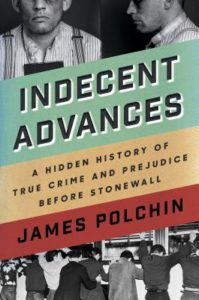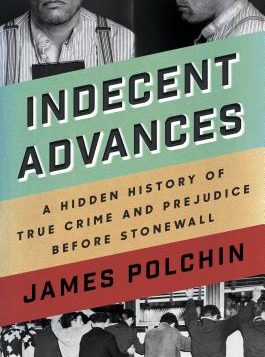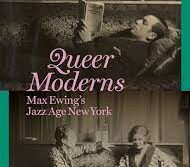 Indecent Advances: A Hidden History of True Crime and Prejudice Before Stonewall
Indecent Advances: A Hidden History of True Crime and Prejudice Before Stonewall
by James Polchin
Counterpoint Press. 225 pages, $26.
THIS YEAR marks the 50th anniversary of the Stonewall Riots, but what preceded those explosive nights in Sheridan Square was decades in the making. In the era before Stonewall, when gay men were forced to lead closeted lives, those who sought to express their sexuality, however furtively, were often victimized and even murdered for doing so. The press coverage of such attacks on gay men was distorted and sensational, and they often turned the victim into the criminal. In Indecent Advances: A Hidden History of True Crime and Prejudice Before Stonewall, James Polchin explores this important feature of the “bad old days” before gay liberation.
In this meticulously researched book, Polchin compiles the “true crime” stories of violence and murder of gay men that were fed to the public, not to garner sympathy for a victimized minority, but instead to expose their nefarious activities after dark, implicitly justifying the attack. By inflaming people’s fears, they justified the criminalization of homosexuality and, in turn, the police raids on gay bars and harassment of gay men. Polchin presents this history and depicts these horrific events chronologically. The author carefully shows how this demonization of homosexuals evolved in the early 20th century. It was during the Harding Administration in the 1920s, an era of growing nationalism, that homosexuals started to be linked with subversives and aliens. FBI Director J. Edgar Hoover would take a more direct approach when he began building files on suspected radicals and subversives, adding sexual deviants in the 1930s. The famous Kinsey study of 1948, while liberating in the long run, increased the public’s awareness of homosexuality, which many perceived as a growing, invisible menace to society. In the decades before Stonewall, the press did not explicitly identify the sexual orientation of victims of violence, but instead ran headlines such as “Man found slain in hotel” or “Man found beaten in park.” But by reading between the lines, the reader would find out that the victim was found naked or that he was older, while the assailant (if apprehended) was a younger man. Many of these victims were married men who had ventured into an area known for gay cruising. If captured, the assailant would often use the “homosexual panic” defense by claiming that the victim had made indecent advances toward him. This was often a successful strategy, typically resulting in the charges being reduced from first- or second-degree murder to manslaughter. As Polchin underscores in these examples, the homosexual panic defense turned the perpetrator into the victim, and vice versa. Such was the case of William Simpson, a flight attendant for Eastern Airlines. In August 1954, he was found shot dead, robbed, and lying in a pool of blood in an area known as Lover’s Lane in Miami. His assailants, Charles Lawrence and Lewis Richard Killen, were eventually captured and confessed to the crime. Their intent was to rob Simpson, but according to Lawrence’s confession, when Simpson made an improper advance, Lawrence shot him. The press reports in The Miami Herald at first described Simpson as a decent, handsome man, but as the homosexual panic defense took hold, he was turned into a dangerous pervert, while Lawrence and Killen became the victims. When the case went to trial, the D.A. was asking for a first-degree murder charge. The two were found guilty, but the jury returned a verdict of manslaughter and sentenced them to twenty years in prison. But it didn’t end there. The Simpson murder produced a panic in the press about the dire problem of a growing homosexual community in the Miami area. The Miami Herald reported that there were over 8,000 homosexuals in Miami and called for a crackdown, prompting police assaults on gay men throughout the city. The Simpson story is one of many examples that Polchin cites of how the media exploited the story, turned a gay man into a criminal, and inflamed an entire city. Moreover, these true crime stories continued to stoke fear of homosexuals in cities for decades to come. Polchin describes how early gay activists became outraged over this media coverage, setting the stage for the early gay rights movement. In 1953, the Mattachine Society’s One magazine started focusing on the unfair media coverage, demonstrating how the press was complicit in the vilification of homosexuals. The editor of One wrote that the Simpson murder “illustrates what trumped up hysteria can do in a few weeks to any city in the United States,” adding: “corrupt politicians and opportunistic demagogues can endanger any community that permits itself to be herded into a pogrom.” James Polchin has written an important book about a critical chapter of LGBT history, carefully documenting the victimization and discrimination that gay men suffered before Stonewall. Much has changed, but discrimination and hate crimes still go on, and there are still many battles left to fight and win. The stories in this book are often heartbreaking and brutal, but the larger story of oppression needed to be told._____________________________________________________
William Burton is a writer based in Provincetown, Mass.





